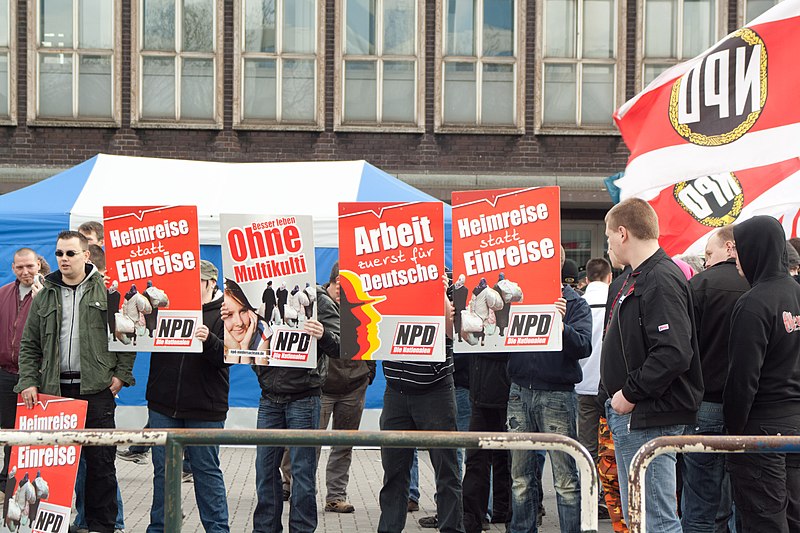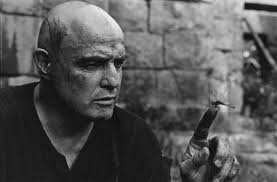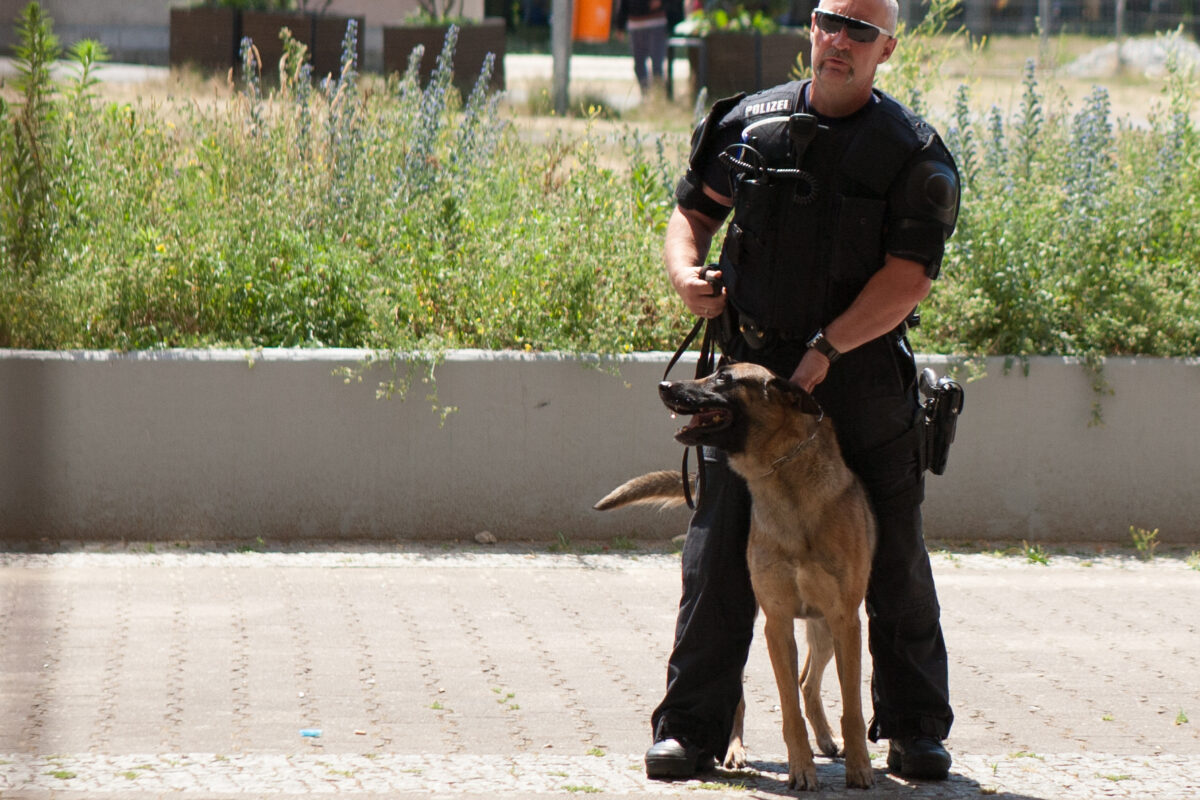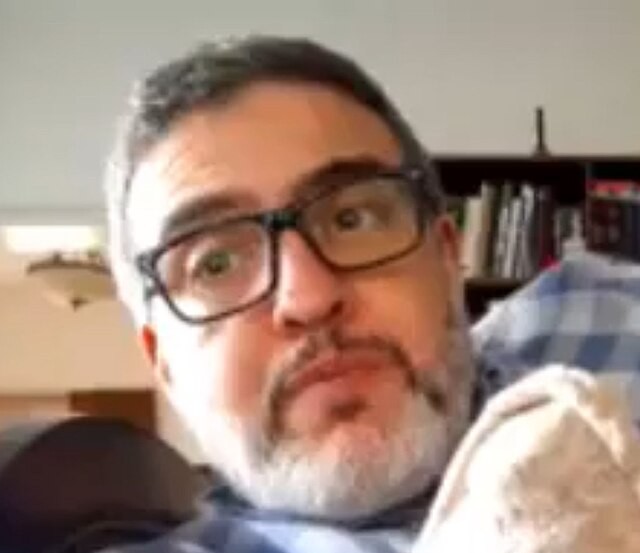Based on a speech I gave to the Marxism 2022 Conference in Melbourne earlier this year. It was a panel discussion on the far right in Europe. I therefore spoke only about general trends. Here I have linked to more detailed articles, in English and German.
I will use three acronyms. AfD is the ‘Alternative für Deutschland’, which sits in the German parliament; PEGIDA, is the ‘Patriotic Europeans against the Islamicisation of the Western World’, is a racist street movement; and the NSU, or ‘National Socialist Underground’ is a pro-Nazi cell which murdered migrants with state support.
It is important to discuss all three organisations to get an understanding of the German far right. In France, Marine Le Pen came within a whisker of the presidency, but she lacks a large street movement to back her up. The potential of a Nazi movement which combines parliamentary representation and street fighters is arguably even more worrying in Germany.
This is not to say that the growth of the German far right has gone uncontested. I conclude with examples of how their inexorable growth was not automatic, and if we organise a broad and militant anti-Nazi movement, we can stop them.
Alternative für Deutschland – Nazis in parliament?
The AfD was formed in 2013, initially as a neoliberal party against the EU. Original party leader Bernd Lucke was an economist, former advisor to the World Bank and long-time CDU member but left the AfD in 2015, saying that it had “fallen irretrievably into the wrong hands”.
The party made an electoral breakthrough in 2017, profiting from the polarisation of German society around the 2015 “refugee crisis” when over 1 million Syrian refugees were allowed to enter Germany. Much of German society welcomed the refugees, organising reception committees at stations. But there were enough insecure racists who became an easy target for the AfD.
At the 2017 election, the AfD received 12.6% of the vote, giving it 94 MPs. This made the AfD the third largest party in the German parliament. As the CDU and SPD formed a coalition government, the AfD became the official parliamentary opposition.
In the elections last September, the AfD vote went down to 10.3%. There are two ways of looking at this result. On one hand, you could welcome the fact that the AfD parliamentary representation had gone down. On the other, over a tenth of the population showed itself prepared to regularly vote for a party where Nazis were increasingly winning hegemony.
The up-and coming star in the AfD, Björn Höcke, is party chief in Thüringen. Höcke is a proper Nazi, making provocative statements like “Christianity and Judaism are an antagonism” and “I don’t want Germany to have only a thousand-year past. I want Germany to also have a thousand-year future.”
Höcke is the leader of the Der Flügel (the wing) group inside the AfD. Der Flügel was officially disbanded in April 2020, after the Federal Office for the Protection of the German Constitution declared it to be a “guaranteed right-wing extremist endeavour against the liberal democratic basic order.” But its members remain active and Höcke still has political ambitions.
As Sabine Am Orde argued in the taz: “the AfD leadership has not drawn personal consequences for Höcke … and other Flügel leaders. They remain influential and powerful in the party and in office. Networks and dependencies will continue to have effect. You don’t lose the ability to organise majorities on which some national party leaders are dependent by just removing a Flügel logo, nor do you lose the extreme right wing ideology.”
Until now, the anti-Fascist Left has preferred to say that the AfD is not a Nazi party, but a party with Nazis in it. I think that this analysis still holds. This is not static nor is it definite that Nazis will not be able to take over the party in the relatively near future.
PEGIDA – a dangerous street movement
Unlike the AfD, there is no dispute about the Nazi background of the PEGIDA leadership. The street movement’s founder Lutz Bachmann was forced to stand down after photos were found of him posing as Hitler. Facebook discussions were also discovered of him describing migrants as “’cattle’, ‘scumbags’ and ‘trash’”
Nonetheless, PEGIDA mobilised tens of thousands, particularly in Eastern Germany. In December 2014, 15,000 joined the ‘pinstriped Nazis’ in an Islamophobic demonstration against “criminal foreigners” in Dresden. The following month, 25,000 demonstrated in the same city. Although they were met with counter-demonstrations attracting at least as many people, an Eritrean refugee was murdered on the night of the demonstration.
In the face of this opposition, PEGIDA was unable to sustain weekly mass mobilisations, but attempted a comeback in 2018. In October, on the 4th anniversary of the first demonstration thousands turned up for a “Monday stroll.” Police were accused of protecting the demo.
Querdenken and Coronaleugner – Covid brings a new wave of right wingers onto the streets
As Covid hit Germany, and Angela Merkel’s government prioritised protecting German industry over public safety, the far right saw an opportunity. A strange mixture of anti-Vaxxers, libertarians and open Nazis took part in a series of demonstrations against government restrictions. Not everyone on these demonstrations was a right-wing extremist: the organisers of the demos professed themselves “neither Right nor Left” and “open to everyone”.
This provided fertile soil for the far right. Sabine Volk from the Centre for the Analysis of the Radical Right noted that “Pegida was among the first groups to claim that it is ‘peaceful‘ activists, not elected representatives, who defend democracy. Not long into the pandemic, a large-scale anti-lockdown movement joined forces with Pegida.”
In a more comprehensive article, Volk noted “continuities and breaks in PEGIDA’s activism during the first wave of the pandemic”. She located PEGIDA as a “social movement organisation inside broader a right wing populist movement.” Voss concludes that “the PEGIDA organisers have used the opportunity to cultivate the image of a resistant political actor”.
In December 2021,Michale Nattke from the Kulturbüro Sachsen noted that “in Saxony we observed over half a year ago that the protests against the pandemic have been taken over step by step by organised Neo-Nazis.” Nattke believed that “we have a similar situation as with the Pegida protests. In Eastern Germany there is the potential that … mobilises exactly the people who were on the streets in 2014 and 2015.”
Protest researcher Dr. Piotr Kocyba noted the presence of PEGIDA and recognised familiar patterns: “I have the impression that I’m experiencing a déja-vu. … Such people are much more dangerous than the extremist fringe of society, because they develop a large mobilisation force, normalise extreme right wing ideas and are not to some extent stigmatized from the majority of society in the way that Neo-Nazis are.”
I would refine Dr. Kocyba’s analysis – it is not that everyone, or even the majority, of people on the Covid demos were neo-Nazis, but that the demonstrations led to a normalisation of the far right. They were able to gain significant influence on many of the demos and in the wider “Querdenker” (lateral thinker) movement.
In Wedding, North Berlin, where I live, the small Monday demonstrations consisted almost entirely of liberal hippies. Nonetheless we organised counter-demonstrations with the slogan “you’re marching with Nazis”. Whatever the individual views of the people on the protests, they were enabling a national movement which enabled the far right to gain influence and build a cadre on the streets.
The NSU Affair – State collaboration with Nazis
I will now move to the most shocking element of the story – the open collaboration of state forces with violent Nazis. Victor Grossman sets the scene: “NSU is the secret pro-Nazi cell which murdered ten men of Turkish or Greek background and a policewoman, blasted a Turkish-populated street with a bomb and robbed several banks. The two main NSU killers died, perhaps suicides, in the closing scenes of this tragic series of events.”
The initial reaction of the police was to harrass the victims’ families. The experience of Abdul Kerim Şimşek, whose father was one of the NSU’s victims was typical: “while his father was still dying, his mother had to go to the police station to make a statement. They asked if her husband was involved in criminal machinations, or if he had an affair or enemies.”
Günther Beckstein, the interior minister of Bavaria briefly considered a racist background. But the investigators assumed from the start that they would find the murderers in the (non-German) drug or mafia scene. The police sent drug-seeking sniffer dogs to the Şimşek family home and tapped their phone. The victims of the murders were made into suspects.
The press talked of a Turkish gang war, and the killings were labelled “Döner-Morden” (Döner murders). As Christian Fuchs reported in Der Spiegel: “over years the murders by the extreme right terror cell were labelled with this phrase. It is evidence of how long investigators and journalists were groping in the dark – but also of how racist prejudices resonated.”
In the end, it seems that the police should have been looking closer to home. V-Männer (police liaison officers) were, according to reporter Stefan Aust “extraordinarily closely involved” in the murders. Forty V-Leute (they weren’t all men) were NSU members, and took part in robberies and murders. One V-Mann was the leader of the violent Nazi group ‘Blood & Honour‘.
When the NSU suspects were raided, police destroyed evidence and provided weapons, at least one of which was present at the crime scene. NSU members were tipped off about forthcoming police raids. When 5 people were finally charged, they were all described as “Einzeltäter” (lone gunman).
The word “Einzeltäter” was to crop up again. When a gunman attacked first a synagogue, then a kebab shop in Halle in 2019, he was called an Einzeltäter. When another far right extremist attacked two shisha bars in Hanau in 2020, killing 9 people with migrant background, he was once more identified as an Einzeltäter.
The German press, the legal system and many politicians have much less problem conceiving of attacks being carried out by crazed individuals than accepting that Germany has a far right racism problem that has often been sustained by the State.
There is a solution: Learning from Dresden Nazifrei
This does not mean that the far right in Germany is on an inexorable rise. Nazi street forces have been stopped before, and they can be stopped again. Just 10 years ago, the largest Nazi demonstration in Europe took part in Dresden every year on the anniversary of that city’s bombing by Allied planes. In 2007 and 2009, 6,500 took part in explicit neo-Nazi demonstrations.
Mass blockades in 2010 and 2011 confronted the Nazis, and in 2012 they were not able to march at all. This was possible because of an alliance ‘Dresden Nazifrei‘, which was both broad and radical. It contained mainstream politicians like Bundestag president Wolgang Thierse (SPD) and the then young LINKE party, but it was absolutely committed to not giving a centimetre of the street to the Nazis.
Such an alliance may be required again soon. As I’ve documented above, the Nazis have not gone away, and have received some support from the German State. The demonstrations, first against refugees, more recently against the Corona measures – succeeded in mobilising at least part of society alongside the far right, especially in the East, which had suffered over 3 decades of neglect.
Less than a year ago, Germany voted in an SDP-Green-Liberal government which proved more eager to double Germany’s military budget than to solve the problems of a broken society. This gives Nazis new opportunities to offer simple solutions, based on nationality not solidarity. They must be stopped. They can be stopped! We must remain vigilant.




